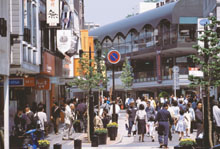In Tokyo’s grand and sprawling department stores, the business day still begins with a ceremonial rite. Moments before the doors swing open, the store manager and key employees form a human tunnel inside the main entrance. As shoppers stream in, the employees bow deeply — a sign of respect to the customers they will be serving.
Japanese consumers continue to command this respect at home and in shopping capitals around the world, although more than a decade of recession and economic malaise has dampened the country’s 1980s spending frenzy. Today’s Japanese consumers have come through a retail evolution that has left them with more choices but a continuing devotion to quality and luxury brands, according to Wharton faculty and Japanese retail executives.
“The mood of consumers is much more optimistic. We have had record retail months from October onwards,” says Jules Takagishi, general manager of sales and marketing in the operations division of Japanese apparel retailer World Co. “Consumers are much more selective now, and they continue to have the attitude that they will pay for quality.” Indeed, according to minutes from the Bank of Japan’s October meeting, available on the web, governors agreed that core consumer prices may start to rise, or at least stop their decline, by the end of 2005.
Consumer spending is key to Japan’s continued economic recovery, with private-sector consumption — 55% of GDP — the biggest component of Japan’s economy. The current improvement in the nation’s business climate could stimulate new spending among consumers who, for years, have held off on key purchases as prices continued to decline. That reticence only exacerbated the nation’s financial slump.
The long economic slump has left its mark on Japanese consumers, notes Takagishi, who has been a guest lecturer in retail operations at Wharton. “The economic recession has changed the psyche of consumers,” she says. “Those who had jobs prior to the bursting of the bubble lived at a time when things were going up and up and up and nothing could go wrong. They are still optimistic in that they believe once the economy gets better, and if they continue to work hard, things will get better.” Younger consumers see things differently. “Those aged 25 to 35, who have only come into the labor market after the economy went south, have watched their parents lose jobs. A lot of the fundamental criteria and beliefs that shaped the working mind in their parents’ generation have crumbled.”
Young people are pessimistic, she adds, and feel the only way to get ahead is to start a business that could hit it big or to become a successful investor. “It is ‘watch out for yourself.’ In larger workplaces, employers are struggling to motivate these younger future leaders because what appealed to the prior generation no longer appeals to them. This generation gap is very serious.”
Another change in the nation’s consumer mindset is a growing divide between rich and poor, says Takagishi. “The Japanese used to believe that we were a country of 128 million middle-class people. Now the divide between the haves and the have-nots is widening and the middle class is falling. Businesses are rushing to introduce products and services that appeal to the wealthy group.”
The Wal-Mart Factor
During the earlier stages of the economic decline, discounters –including Costco, Wal-Mart and domestic off-price chains — moved into Japan with off-price stores, often in new suburban developments. These retailers enjoyed some success at first, according to Masa Nagatake, chief executive of the U.K. subsidiary of Uniqlo, a Japanese clothing retailer. “If you compare today to 15 years ago, yes, there are more discounters now, but there was a period from the late 1980s to the late 1990s after the economic downturn when there were lots of discounters in Japan. Now, some of those people have disappeared.”
Japanese consumers initially flocked to the discounters because of their novelty, but were soon turned off by items that were of lower quality than consumers were used to, says Nagatake. “There was a year or two of people going to discounters and buying cheap stuff, but if the quality didn’t meet consumer expectations, the shoppers didn’t go back,” he says. “Consequently, very few people survived being price-cutters.”
He points to the bankruptcy of the Daiei supermarket and discount chain, and problems at Seiyu — another discount chain, as examples of discounting failures. Wal-Mart, which had a partial stake in Seiyu, paid $574 million on December 15 to take a majority stake (53.5%, up from 42.2%). In September, Wal-Mart reported that losses for the first six months at Seiyu had increased nearly fourfold, to $94 million. Wal-Mart has also announced an executive shakeup at corporate headquarters in Bentonville, Ark., flipping its top domestic and international executives. Analysts said the move was, in part, due to problems in Japan.
“Wal-Mart is struggling. The way it managed [its operations] in Japan didn’t seem to work at all,” says Nagatake, adding that Wal-Mart simply transferred its way of doing business in the United States to Japan — a strategy that flopped. “Everyday low prices worked well in the U.S. and maybe for the low-income population, but in Japan, people are very quality oriented.”
To Nagatake, it now seems that consumer prices in Japan are beginning to stabilize. “For the last couple of years prices have been holding quite steady.” He said there was a significant drop in consumer prices throughout the 1990s, although the decline was not as sharp as the drop in real estate prices.
While managers continue their morning rituals at Tokyo’s signature department stores, the recession has created a shift in shopping patterns away from the traditional department stores, according to Tagakishi. Instead, collections of shops grouped in vertical malls at major train stations are attracting more of today’s shoppers. This year, Japan’s national railroad company earned more revenue from merchandise sales at these retail developments than from the sale of train tickets.
In addition, she notes, while the nation’s small mom-and-pop stores remain entrenched, in the future they will consolidate as shop owners die out and their children decline to take over the family business. “Many smaller retailers are suffering from a lack of human capital. The children have gotten a higher education and have gone off to work in corporations, combined with the fact that they have fewer children than the last generation. So the pool of people available to [take over] small retail operations is shrinking.” Meanwhile, regulations, which have protected small retailers from large competitors, may ease up, but “the most serious problem” she says, “is people.”
The Appeal of Prestigious Brands
Despite its economic problems, Japan remains a healthy market for high-end luxury brands. Hermes, the French accessory retailer of prestige scarves and handbags, reaps 25% of its sales from Japan. For Louis Vuitton, another Parisian luxury retailer, that figure is 50%, according to Takagishi.
Wharton marketing professor Barbara Kahn points out that Toyota this year will introduce its luxury brand, Lexus, into its home market for the first time. “They are trying to compete with BMW and Mercedes. It’s all very upscale. The salespeople are all well-trained and they make the whole car-buying process a big ceremony.”
Kahn, who traveled to Japan this fall, noticed that retail space is now leased to brand-name companies loaded with cachet, including Armani and Prada. “Japan is pretty big into brands — and prestigious brands.” Japanese shoppers gravitate to these brands for the same reasons affluent shoppers from any country do. “It is a reflection of status and of your values and tastes.” In addition to quality, service also remains an important component of Japanese retailing, adds Kahn. “Whenever I am there, I notice the level of service is so high. You go into a store and they actually help you. It’s just amazingly great service. The contrast between Japan and the U.S. is like night and day.”
As for supply chain management, Japanese retailers have refined their supply chain operations and developed close marketing ties to their customers, according to Marshall Fisher, Wharton operations and information management professor. He points to Seven Eleven, the Japanese company that owns 7-Eleven stores in the United States and in Japan. Fisher says the company is highly regarded as an innovative retailer in Japan where, for example, 7-Eleven has focused on improving its tuna supply chain to appeal to Japan’s discriminating sushi buyers. The chain, among other things, carefully analyzes consumer preferences in tuna, such as color and freshness. “They have really made a science of it. They have figured out how to slow down the rate the tuna changes color to slow down the aging process of the tuna — at least as it is perceived by the customer.”
On the marketing side, as Japanese shoppers check out at 7-Elevens, employees track sales by the customer’s gender and estimated age. That gives the parent company critical information about buying patterns. And 7-Eleven has set up a franchise model to work with Japan’s popular mom-and-pop groceries that allows the small operations better access to bulk buying and advertising, yet maintains the friendly, neighborhood feeling that Japanese consumers value.
“The Japanese approach to retailing is similar to their approach to other industries, such as autos, where their practices have become famous,” says Fisher. “There is a lot of focus on understanding the consumer, getting data and then” quickly coming up with “designs for new products, such as the tuna example.”
A third important characteristic of Japanese retailing, notes Fisher, is a strong reliance on employees who work the shop floor. In the United States, executives at large retailer chains plan elements of the business, such as which products to mark down. They dictate those plans to low-paid front-line employees who usually have little advanced education.
In Japan, says Fisher, top retail executives rely on highly trained employees in their shops to send information up to them. “The Japanese model is to make the data available to people in the stores and let them make the decisions. Management equips them with good training and concepts, but the philosophy is that they are present on the firing line and are better able” to decide the right course of action, says Fisher. “U.S. executives feel that is inefficient. It costs a lot to have highly talented people spread across 500 stores.”
Japanese retail management may be a reflection of the nation’s business culture, one that emphasizes speed in responding to short-term concerns, such as inventory replenishment or developing supply chains, but that takes a slower, long-term approach when it comes to restructuring institutions or financial reform, fisher suggests. “On one level, there is great emphasis on speed, and in other areas it is just the opposite. It’s a little surprising that they are so different day-to-day versus the long-term.”



